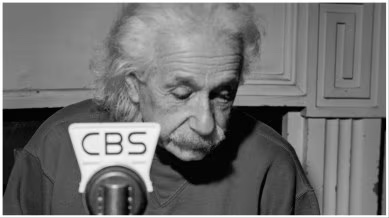With the production values of a hastily made Saturday Night Live sketch and all the visual splendour of a Sora video, Netflix’s Einstein and the Bomb fails — in every possible way — to provide any actual insight about the renowned theoretical physicist. Charitably speaking, the hour-long docudrama is a blatant attempt to piggyback on the popularity of Christopher Nolan’s Oppenheimer, without bothering to match the blockbuster film’s ambition or complexity in a meaningful manner.
Einstein and the Bomb combines extensive dramatic reenactments and a smattering of archival footage, but with zero expert input. The film begins with the claim that every word in it was either spoken or written by Einstein himself. Everything that we see is supposedly hard fact. It’s fairly reasonable, therefore, for the viewer to expect the film to uncover interesting details about his life and personality, especially since so much of it has been documented. But some of the creative choices here, regardless of the resources available, are simply bizarre to behold.
Einstein and the Bomb traces Einstein’s journey as a political refugee in England to his stint at Princeton University in the United States. This is when he crossed paths with J Robert Oppenheimer (in a made-up scene) in Nolan’s film. You’d perhaps be a little dismayed to learn that Oppenheimer doesn’t make an appearance in Einstein and the Bomb at all. In fact, he isn’t even mentioned. The movie does, however, address Einstein’s tangential role in the creation of the world’s first atomic bombs, as well as the guilt that he was subsequently tortured by in the days following America’s bombing of Hiroshima and Nagasaki. The problem is that it doesn’t view this as incidental complicity, but as an innocent mistake.
Aidan McArdle plays Einstein in the reenactments, although director Anthony Philipson seems to be under the impression that makeup is more important than an actor’s performance. In virtually every frame, McArdle looks like he’s wearing an Albert Einstein mask — not the plastic kind you’d get at a toy shop, but the sort of mask that Buffalo Bill carves from the skin of his victims in Silence of the Lambs. It’s massively distracting, as if the stilted dialogue wasn’t already damaging the film.
The first 30-odd minutes of the movie are devoted entirely to Einstein’s ouster from Germany, where his vocal opposition of Adolf Hitler and the Nazi party painted a target on his back. Einstein fled to England, where, like Taylor Swift during the pandemic, he fully embraced a cottagecore aesthetic and lived in the countryside with two armed female guards for company. In the film, he spends this time regaling his companions about relativity — “an hour sitting on the park bench with a pretty girl feels like a minute, and a minute sitting on a hot stove feels like an hour” — and also contemplating the potentially dangerous implications of his theories.
Einstein describes himself as a ‘militant pacifist’. “Organised force,” he says, “can only be opposed by organised force.” And this is why he co-signed a letter addressed to the then-US President Franklin D Roosevelt, urging him to initiate a nuclear programme before the Nazis beat everybody to it. This was perhaps his biggest contribution to the creation of the atomic bombs; Einstein wasn’t invited to join the Manhattan Project owing to his vocal politics. But the film doesn’t exactly indict the Americans for what is generally considered to be a war crime, although, admittedly, Einstein and the Bomb underlines the fact that the Americans attacked Japan after it was already clear that the war had been won.
Speaking of pure evil, the film also recreates a speech that Einstein made at the Royal Albert Hall in 1933, denouncing Hitler’s rise in the clearest of terms. Real footage of this speech exists, but Einstein and the Bomb chooses to use only about six seconds of it, as if it is actively trying to stay within the parameters of the fair use policy. To find a way around this invented obstacle — remember, it was probably impossible for Einstein and the Bomb to recreate the entire speech in a packed hall — the filmmakers take us backstage, where they take the ‘jugaadu’ approach by showing us Einstein’s nervous rehearsals.
A part of you can’t help but admire problem-solving such as this. But then again, this isn’t a student film, or one of those informative videos that play on a loop at museums, projected against an empty wall. It’s a proper movie that Netflix has deemed worthy of a prominent spot on its already overpopulated homepage. This is prime real estate, the sort of spot that would typically be assigned to an actual Nolan film, as opposed to something that is merely riding on the coattails of one.
Post a Comment
0CommentsHot Posts
4/footer/recent
Labels
Search This Blog
Most Recent
Adult star Kagney Linn Carter's chilling final Instagram post just days before suicide
February 19, 2024Did Marvel just confirm the Taylor Swift cameo? Friendship bracelets approve this message
February 19, 2024Cillian Murphy, Best Actor winner - Bafta
February 19, 2024Abhilasham gets a release date, trailer out
March 23, 2025Views Earned
Our goal is to earn 1B views. Guide us the way
Design by - Blogger Templates | Owned and managed by STAGE SCREENING

